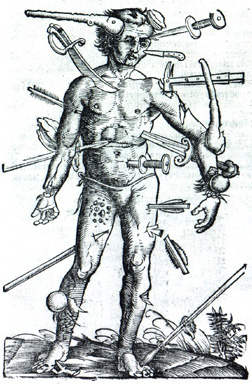Wound Man
The Wound Man is an illustrative figure that appears in surgical and medical texts from the late Middle Ages and the Renaissance. It depicts a human (usually male) standing with arms slightly outstretched, displaying a variety of wounds and traumas throughout the body. These illustrations served as a visual guide for treating injuries related to warfare, accidents, and surgical procedures. The Wound Man is a significant historical artifact, illustrating the state of medical knowledge and the types of injuries that were common or of concern at the time.
Origins and History[edit | edit source]
The earliest known version of the Wound Man appears in European surgical manuals of the 15th century, although the concept may have older roots. The image encapsulates the medical knowledge of the time, combining practical treatment advice with a compendium of possible injuries. It was a time when medicine was closely linked with both the study of anatomy and the practice of surgery, and the Wound Man served as an educational tool for physicians and barber-surgeons.
Description[edit | edit source]
The Wound Man typically shows a variety of injuries, including cuts, punctures, and fractures, as well as diseases and conditions such as tumors and skin infections. The figure also often includes representations of treatments, such as bandaging techniques and the removal of arrows or other foreign objects. Each wound or condition is usually labeled, providing a guide to treatment options available at the time.
Significance[edit | edit source]
The Wound Man is more than just a medical illustration; it is a window into the medical practices and challenges of the past. It reflects the types of injuries that were prevalent or of particular concern, such as those sustained in battle or through accidents. Additionally, it demonstrates the intersection of medical knowledge and societal needs, showing how physicians and surgeons were expected to treat a wide range of conditions.
Legacy[edit | edit source]
While the Wound Man is primarily of historical interest today, it remains a fascinating example of early medical illustration and education. It highlights the evolution of medical knowledge and the ways in which practitioners of the past visualized and categorized injuries. Modern medical education still uses illustrations to teach anatomy and treatment, though with far greater accuracy and detail, thanks in part to advances in medical science and technology.
See Also[edit | edit source]
Wound_Man[edit | edit source]
Search WikiMD
Ad.Tired of being Overweight? Try W8MD's physician weight loss program.
Semaglutide (Ozempic / Wegovy and Tirzepatide (Mounjaro / Zepbound) available.
Advertise on WikiMD
|
WikiMD's Wellness Encyclopedia |
| Let Food Be Thy Medicine Medicine Thy Food - Hippocrates |
Translate this page: - East Asian
中文,
日本,
한국어,
South Asian
हिन्दी,
தமிழ்,
తెలుగు,
Urdu,
ಕನ್ನಡ,
Southeast Asian
Indonesian,
Vietnamese,
Thai,
မြန်မာဘာသာ,
বাংলা
European
español,
Deutsch,
français,
Greek,
português do Brasil,
polski,
română,
русский,
Nederlands,
norsk,
svenska,
suomi,
Italian
Middle Eastern & African
عربى,
Turkish,
Persian,
Hebrew,
Afrikaans,
isiZulu,
Kiswahili,
Other
Bulgarian,
Hungarian,
Czech,
Swedish,
മലയാളം,
मराठी,
ਪੰਜਾਬੀ,
ગુજરાતી,
Portuguese,
Ukrainian
Medical Disclaimer: WikiMD is not a substitute for professional medical advice. The information on WikiMD is provided as an information resource only, may be incorrect, outdated or misleading, and is not to be used or relied on for any diagnostic or treatment purposes. Please consult your health care provider before making any healthcare decisions or for guidance about a specific medical condition. WikiMD expressly disclaims responsibility, and shall have no liability, for any damages, loss, injury, or liability whatsoever suffered as a result of your reliance on the information contained in this site. By visiting this site you agree to the foregoing terms and conditions, which may from time to time be changed or supplemented by WikiMD. If you do not agree to the foregoing terms and conditions, you should not enter or use this site. See full disclaimer.
Credits:Most images are courtesy of Wikimedia commons, and templates, categories Wikipedia, licensed under CC BY SA or similar.
Contributors: Prab R. Tumpati, MD




